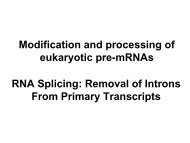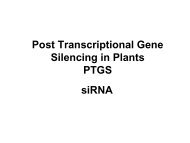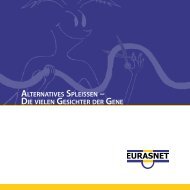You also want an ePaper? Increase the reach of your titles
YUMPU automatically turns print PDFs into web optimized ePapers that Google loves.
Following feedback from members we have modified the form for obtaining information on the activities of the<strong>EURASNET</strong> groups to facilitate information gathering and reporting.256 Regular requests for information from membersThe web team actively request information from <strong>EURASNET</strong> members for the web site and for dissemination. In addition,automatic literature searches are carried out to identify publications from <strong>EURASNET</strong> members such that an up-to-date listis maintained on the website.<strong>Report</strong>All of the members of the <strong>EURASNET</strong> network are continually involved in promoting the importance of alternative splicingto the wider RNA community. In addition to this WP, other dissemination WPs (e.g.WP16 – Conferences/meetings) and thenew website (WP1) are engaged in transferring knowledge and practical skills in RNA biology and alternative splicing.Following the first year Review <strong>Report</strong> which suggested the need to better quantify the intensity of the activities of theNetwork, we designed a form to allow members to register their many different activities in a range of classifications (e.g.presentations at workshops, national RNA groups or meetings, national/international meetings; organisation ofnational/international meetings; invited seminars; presentations/consultancy to industry/SMEs; consultancy to therapeuticgroups; education of RNA focused students). As part of the reorganization of the website and the closer links between WP1,WP19 and WP21, we have set up a web team with responsibility for interacting with members, ensuring repeated requestsfor information at regular intervals and collating information. Finally, to help to raise awareness of molecular aspectsalternative splicing and new technologies for assessing its impact, we have identified groups of medical scientists andclinicians and inform them of upcoming meetings and workshops and website updates.The <strong>EURASNET</strong> network is continually involved in promoting the importance of alternative splicing to the wider RNAcommunity. This is achieved through a range of different activities including presentations at <strong>EURASNET</strong>-organisedworkshops, seminars, talks and posters at national and international meetings, presentations to industry, communication withgroups involved in disease therapy and in talks to RNA-orientated PhD students. In addition, some members of <strong>EURASNET</strong>are also involved in other RNA-based EU projects and networks allowing the transfer of information and knowledge amongRNA groups across Europe.The major route for disseminating information on alternative splicing to the wider RNA community is in the publication ofrefereed papers and presentations of research at national and international meetings. The latter often include the publicationof abstracts or conference proceedings reflecting oral or poster presentations. The acknowledgement of EU-FP6 funding andthe inclusion of the <strong>EURASNET</strong> logo in acknowledgement slides and on posters reinforces the activities of <strong>EURASNET</strong> tonon-<strong>EURASNET</strong> participants.Another main avenue of interaction with the RNA community in Europe is through workshops and meetings organized by<strong>EURASNET</strong> (see WP16 – Conferences meetings). The <strong>2008</strong> reporting year saw the 1 st International Alternative Splicingmeeting organized by <strong>EURASNET</strong> and held in Kracow, Poland. In addition, a number of workshops and interdisciplinaryfocused meetings were organized. Besides those directly involved in organizing these workshops and meetings, an importantaspect of the success of the workshops and meetings is that other <strong>EURASNET</strong> members are called upon to contribute bygiving presentations on their alternative splicing research. All of these activities attract non-<strong>EURASNET</strong> RNA biologistsand increase awareness of alternative splicing through the transfer of knowledge and practical skills.Publications acknowledging <strong>EURASNET</strong> - <strong>2008</strong>ActivityNumberRefereed publications from one <strong>EURASNET</strong> lab 64Refereed publications from interactions between more than one <strong>EURASNET</strong> lab 18Conference proceedings involving one <strong>EURASNET</strong> lab 68Conference proceedings from interactions between more than one <strong>EURASNET</strong> lab 38The number of publications clearly reflects the scientific activity of the Network. The publications involving more than one<strong>EURASNET</strong> lab reflects the increasingly active interactions among the groups and the added value which the network isbringing to this community.The wide range of other activities in communication of alternative splicing research and the <strong>EURASNET</strong> network includepresentations at <strong>EURASNET</strong> workshops, national RNA groups or meetings, the organisation by <strong>EURASNET</strong> members ofnational and international meetings and presentations at these meetings, invited seminars, interactions with industry,consultancy and discussions with scientists/clinicians involved in therapy for diseases due to altered splicing or alternativesplicing and talks/discussions to RNA-orientated students to promote interest and future careers in the field of alternativesplicing. These activities are quantified below and illustrated with a number of examples.76







